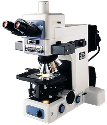Nikon Eclipse E 800 Wide Field Fluorescence
 Nikon Eclipse E 800 Wide Field Fluorescence location: AS8-2029 status: in service reserve use
Nikon Eclipse E 800 Wide Field Fluorescence location: AS8-2029 status: in service reserve use
Upright wide field fluorescence scope with color camera. DIC optics. Manual control.
E-800 optical system features advanced universal objectives for multiple observation techniques, including brightfield, darkfield, differential interference contrast (DIC), epi-fluorescence and phase contrast.The exceedingly long working distances, coupled with high numerical apertures of Nikon's CFI60 optics, allows for easier handling of even relatively thick specimens, provides superior resolution, and offers improved image capability with the elimination of optical aberrations. Can be used for fluorescence applications, such as video-enhanced contrast (VEC), fluorescence in-situ hybridization (FISH), as well as other microscopy applications. The low-profile stage has extended stage travel for movement and is centerable and rotatable. The space between the microscope arm and stage is greatly enlarged compared with conventional microscope bodies, facilitating nosepiece rotation and the use of objective correction collars.
Objectives:
20x, planar fluor, na 0.5
40x, plan fluor, n.a. 0.75
60x, plan APO, XA, n.a. 1.40, oil DIC
100x plan APO, VC, n.a. 1.40 oil
Illumination: X-Cite 120 Fluorescence Illumination System with adjustable aperture
Fluorescence Filters
FITC-HYQ (480nm/535nm) Earlier longpass and bandpass design for fluorescein but is useful for yellow fluorescent protein studies
UV-2E/C
The Nikon UV-2E/C fluorescence filter combination is designed to provide bright, high-performance imaging with a steep sloped bandpass emission filter to block crossover from longer wavelength emission in multiply labeled specimens. Ultraviolet and visible transmission spectral profiles for this combination are illustrated below in Figure 1. This set is designed for medium bandwidth (40-nanometer) ultraviolet excitation, centered at 360 nanometers, with a corresponding longpass dichromatic mirror (cut-on wavelength of 400 nanometers) and medium (50-nanometer) bandpass emission filter.

Ultraviolet Excitation Filter Block UV-2E/C Specifications
| Excitation Filter Wavelengths | 340-380 nm | Bandpass 360 center |
| Dichromatic Mirror Cut-on Wavelength | 400 nm | Longpass |
| Emission Filter Wavelengths | 435-485 nm | Bandpass 460 center |
The UV-2E/C combination is designed as a sharp cut-off filter block for ultraviolet fluorescence analysis of specimens labeled with two or more probes. Filters are the soft-coated type intended to generate a high signal-to-noise ratio. The narrow bandpass emission (barrier) filter utilized in this combination is designed to cut off green and red visible wavelengths to minimize spectral bleed-through. Specific applications include the following popular chromophores: Alexa Fluor 350 and 405, 7-amino-4-methylcoumarin (AMC), and its acetic acid derivatives (AMCA-S and AMCA), aminocoumarin, anthroyl stearate, bisaminophenyloxadiazole (BAO 9), bisbenzamide, Calcein Blue, coumarin phalloidin, Fast Blue, 4',6-diamidino-2-phenylindole (DAPI; blocking fluorescein (green) and tetramethylrhodamine (red) in triple labeled specimens), Hoechst 33258/33342, Cascade Blue, and True Blue.
G-2A
The Nikon G-2A filter set is designed as the standard combination for use with green excitation wavelengths, and employs a wide (50-nanometer) excitation passband that covers essentially the entire green spectral region, from 510 to 560 nanometers. Ultraviolet, visible, and near-infrared transmission spectral profiles for this filter combination are illustrated below in Figure 1. Combined with the 590-nanometer cut-on wavelength of the longpass emission filter, the G-2A set enables detection of a wide range of fluorochromes emitting at wavelengths longer than those in the yellow region and extending into the near-infrared spectral zone. The dichromatic mirror has a cut-on wavelength specification of 565 nanometers.

Green Excitation Filter Block G-2A Specifications
| Excitation Filter Wavelengths | 510-560 nm | Bandpass 535 center |
| Dichromatic Mirror Cut-on Wavelength | 565 nm | Longpass |
| Emission Filter Wavelengths | 590 nm | Longpass |
The G-2A filter combination is designed to perform with a wide range of fluorochromes excited by green wavelengths, and is considered the standard Nikon filter block for green excitation. The combination of a wide excitation passband (50 nanometers) with a longpass emission (barrier) filter enables detection of fluorescence intensity from a substantial range of fluorophores that emit in the orange through near-infrared spectral regions (restricted to wavelengths longer than the 590-nanometer barrier filter cut-on wavelength). The resulting images are bright, although signal-to-noise ratios are typically lower than those produced with combinations employing bandpass barrier filters (such as the G-2E/C and Cy3). The G-2A set is recommended when studying the following fluorophores: Acridine Red, Alexa Fluors (532, 546, 555, 568, and 594), Alizarin Red, BODIPY probes, Calcium Orange, Cy3, Cy3.1.8, ethidium bromide, FluoroRuby, FM 5-95, hexachlorofluorescein (HEX), LDS 751-DNA, MitoTracker Orange and Red, POPO-3, PO-PRO-3, propidium iodide (PI), Pyronin B, RedoxSensor Red CC-1, RH probes (237, 414, 421, 795), many rhodamine derivatives, Sevron Brilliant Red, SYTO derivatives, SYTOX Orange, and Xylene Orange. The images presented in Figure 2 demonstrate the performance of this filter combination with a variety of green-absorbing fluorescence probes targeted at different intracellular locations.
Camera: coming soon.....Photometrics Coolsnap HQ2 with 1024 x 1024 pixels. (currently has Canon D30 DSLR).
Documentation downloads: E-800 instruction manual